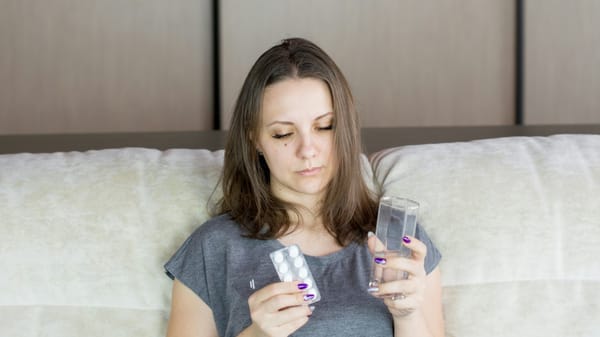The Hidden Dangers of Mold and the Impact on Teenagers and Hormonal Health
Is mold quietly sabotaging your teenager’s health? High humidity and mold growth can throw hormones off balance, affecting mood, energy, and even academic performance. Discover the hidden dangers and practical solutions in this must-read guide.

Imagine a typical suburban home, seemingly perfect on the surface. But beneath the pristine facade, hidden away in the damp corners of the basement, lurked something far more sinister-mold. Little did the family know that this unseen threat was quietly disrupting the hormonal balance of their teenage daughter, causing irregular menstrual cycles and mood swings. As she struggled with these mysterious symptoms, the real culprit remained hidden until a chance discovery revealed the shocking truth behind her health woes.
Emerging research suggests that mold exposure and excessive humidity can interfere with the delicate balance of female hormones, disrupting the body in ways that often go unnoticed until symptoms become severe. From estrogen imbalances to adrenal dysfunction, these environmental toxins can silently impact physical and emotional well-being.
This article dives deep into how mold and humidity affect teenage girls' hormonal health, incorporating also insights from Chinese medicine and biohacking strategies. If you’ve ever wondered whether your home environment could be influencing your teen’s well-being, keep reading, you might be surprised by what you learn.
How Mold and Humidity Disrupt Teen Health
Most people don’t think twice about mold or high humidity, until health problems arise. For teenagers, especially girls, prolonged exposure to these environmental factors can have serious consequences. The hormonal system, immune response, and even mental well-being can all be affected in ways that are often misdiagnosed or overlooked. While mold might seem like a minor household nuisance, its mycotoxins can silently disrupt critical bodily functions, leading to lasting health complications.
One of the most concerning effects of mold exposure is hormonal disruption. Mycotoxins, the toxic substances produced by mold, can interfere with the endocrine system, throwing hormone levels out of balance. Teenage girls, whose hormonal systems are still developing, are particularly vulnerable. Mycotoxins such as zearalenone mimic estrogen in the body, potentially leading to estrogen dominance. This can result in irregular menstrual cycles, unexplained weight gain, mood swings, and, in some cases, even early puberty. High humidity only worsens the situation by fueling mold growth and increasing exposure to these harmful compounds. Over time, chronic inflammation caused by mold can further dysregulate hormone production, making it difficult for the body to maintain balance. Mold exposure also places a significant burden on the immune system. When the body detects mold toxins, it triggers an immune response that releases inflammatory cytokines. If exposure continues over time, chronic inflammation can develop, affecting the hypothalamus-pituitary-adrenal (HPA) axis, the system responsible for regulating stress hormones. A dysregulated HPA axis can lead to persistently high cortisol levels, which negatively impact sleep, energy levels, and mood stability. This is particularly concerning for teenagers, who need proper rest and emotional stability for healthy growth and development.
Another critical risk is thyroid dysfunction. Mold toxins can interfere with the production and regulation of thyroid hormones, increasing the risk of hypothyroidism or autoimmune conditions like Hashimoto’s disease. Symptoms such as persistent fatigue, difficulty concentrating, and unexplained weight gain can be devastating for a teenager's academic performance, physical health, and overall quality of life. For teenage girls, reproductive health risks are another major concern. Mold exposure has been linked to conditions like polycystic ovary syndrome (PCOS) and endometriosis, both of which are associated with estrogen imbalances. These conditions can cause painful periods, fertility issues, and long-term reproductive health complications.
Finally, the mental health impact of mold exposure cannot be ignored. The hormonal imbalances caused by mold can contribute to anxiety, depression, and brain fog. Since the teenage brain is still developing, any disruption to neurotransmitter function can have long-lasting effects on emotional regulation and cognitive performance.
While mold and humidity may seem like minor environmental factors, their effects on teenage health are far-reaching. Understanding these risks is the first step toward creating a healthier environment for young people to thrive.
Ancient Wisdom Meets Modern Biohacking: Tackling Mold Toxicity Holistically
Mold exposure has long been recognized as a serious health threat, but different healing traditions offer unique approaches to understanding and combating its effects. Traditional Chinese medicine (TCM) views mold as a form of "dampness," a pathogenic factor that disrupts the body's balance, while modern biohackers like Dave Asprey emphasize detoxification and environmental control to minimize mold’s harmful impact. Together, these perspectives provide a powerful framework for addressing mold toxicity from both ancient and modern standpoints.
In TCM, dampness is closely tied to environmental conditions—high humidity, poor ventilation, and excess moisture in the body all contribute to an accumulation of damp energy. When dampness takes hold, it weakens the spleen, which is responsible for digestion and fluid transformation. This can lead to bloating, sluggish digestion, low energy, and even mental fog. The lungs, too, are affected, as mold exposure can trigger respiratory issues and chronic congestion. The kidneys, which play a role in detoxification and fluid balance, may also suffer, leading to water retention and fatigue. According to TCM, eliminating dampness is key to restoring health. This is done through dietary changes, herbal remedies, and acupuncture. Warming spices like ginger, turmeric, and garlic help to counteract dampness, while herbs such as astragalus and milk thistle support detoxification. Acupuncture is used to improve energy flow, particularly in the spleen and kidney meridians, helping the body process and eliminate toxins more efficiently. Prevention is also emphasized—keeping indoor spaces dry, ventilated, and free of mold is just as important as treating its effects.
Consider the the importance of environmental control, advocating for HEPA air filters, UV light purifiers, and strict humidity regulation to prevent mold growth and the need for detoxification, using binders like activated charcoal and glutathione supplements to remove mycotoxins from the body. Our dietary recommendations align with TCM, avoiding mold-prone foods such as grains and nuts and focusing on hormonal balance, suggesting bioidentical hormones and adaptogenic herbs like ashwagandha to regulate cortisol and thyroid function, both of which can be disrupted by mold exposure.
By integrating these two approaches, individuals can adopt a well-rounded strategy to combat mold toxicity. Combining ancient wisdom with modern biohacking techniques allows for a more comprehensive and effective way to restore balance, detoxify the body, and protect long-term health.
Healing from Mold Exposure: A Comprehensive Approach
Mold exposure can have severe health consequences, but both conventional and alternative medicine offer effective strategies for treatment and long-term recovery. Understanding the full spectrum of available approaches allows individuals to make informed decisions about their health, combining medical treatments with holistic methods for optimal healing.
Conventional medicine primarily focuses on eliminating mold-related infections and reducing the body’s toxic burden. Antifungal medications such as voriconazole and amphotericin B are used to treat invasive mold infections, particularly in individuals with weakened immune systems. Immunotherapy, including antigen injections, helps desensitize the immune system and reduce allergic responses to mold. Detoxification support is also a key component, with supplements like glutathione and N-acetylcysteine (NAC) aiding the liver in processing and eliminating mold toxins. To prevent mycotoxins from being reabsorbed in the gut, binders such as cholestyramine and activated charcoal are commonly prescribed. These treatments are effective but often work best when combined with broader lifestyle changes.
Functional and holistic medicine take a more individualized approach, focusing on identifying specific mold toxins through urine mycotoxin tests and tailoring treatments accordingly. Diet plays a crucial role in reducing inflammation and strengthening the immune system, with probiotics, anti-inflammatory foods, and omega-3 fatty acids supporting gut health and reducing systemic inflammation. Infrared sauna therapy is also gaining popularity as a method to accelerate detoxification, allowing the body to eliminate toxins through sweat. Herbal antifungals like garlic, turmeric, and berberine have been shown to possess natural mold-fighting properties, while ozone therapy is used to regulate immune function and reduce inflammation. These alternative treatments work alongside conventional medicine to enhance recovery and restore balance to the body.
Preventing further mold exposure is just as critical as treatment. Short-term mitigation strategies include using HEPA air purifiers, keeping indoor humidity levels below 50%, and addressing water leaks or moisture buildup. For those in high-risk environments, wearing N95 masks and protective clothing when cleaning mold-infested areas can help minimize exposure. Detoxification methods such as taking activated charcoal and increasing water intake further support the body’s ability to eliminate toxins. Symptom management, including antihistamines and nasal sprays, can provide relief from respiratory distress.
Long-term healing requires ongoing vigilance. Regular mycotoxin testing helps monitor exposure levels, while lifestyle adjustments, such as following a low-mold diet and managing stress with adaptogenic herbs, support the body’s resilience. Environmental remediation, including routine mold inspections and proper ventilation, ensures a healthier living space. By integrating medical treatments with holistic strategies and proactive prevention, individuals can effectively recover from mold toxicity and safeguard their long-term well-being.
Identifying Toxic Molds in Your Home
Mold isn’t just an eyesore, it can be a serious health hazard. While some molds are relatively harmless, others produce potent mycotoxins that can cause respiratory problems, immune suppression, and even neurological damage. Knowing which molds are dangerous and how to identify them is key to protecting your health.
Most Harmful Types of Mold
- Stachybotrys chartarum (Black Mold) – Highly toxic; linked to:
- Severe respiratory issues (wheezing, chronic cough)
- Chronic fatigue
- Neurological symptoms (dizziness, brain fog, memory loss)
- Memnoniella echinata – Similar to black mold; causes:
- Immune system suppression
- Increased vulnerability to infections
- Aspergillus – Common in household dust and damp areas; produces:
- Aflatoxins (carcinogenic toxins affecting the liver and lungs)
- Breathing difficulties and allergic reactions
- Fusarium – Found in water-damaged homes; linked to:
- Neurological symptoms (numbness, confusion)
- Skin and eye infections
- Life-threatening infections in immunocompromised individuals
- Chaetomium – Thrives in water-damaged buildings; can lead to:
- Autoimmune diseases
- Chronic inflammation
- Brain fog and difficulty concentrating
- Penicillium – Can produce harmful mycotoxins, leading to:
- Kidney and liver damage
- Allergic reactions and asthma
- Alternaria – A common allergen that can trigger:
- Asthma attacks
- Skin infections
- Chronic sinus issues
How to Spot Toxic Mold in Your Home
- Color Clues: Watch out for black, green, brown, or pink mold patches.
- Texture Warnings: Slimy, fuzzy, or powdery textures often indicate toxicity.
- Unmistakable Odor: A strong, musty smell is a red flag for hidden mold.
- High-Risk Locations: Mold thrives in damp places like:
- Bathrooms
- Basements
- Under sinks and carpets
- Around windows and water leaks
Because mold exposure can have severe health consequences, early detection is crucial. If you notice any of these warning signs, act fast, removing toxic mold promptly can help protect your well-being and create a safer home environment.
The Hidden Killer in Jordan’s Home: How Toxic Mold Wreaked Havoc on Her Health
Jordan, a lively 15-year-old girl, had always been the picture of health. However, over the past few months, she noticed something strange happening to her body. Her menstrual cycle became irregular, and she experienced sudden mood swings and unexplained fatigue. Despite her best efforts to stay healthy, nothing seemed to make a difference.
One evening, Jordan’s mother, Sarah, decided to clean the bathroom. As she scrubbed the tiles, she noticed a peculiar musty smell. Intrigued, she followed the scent to the back corner of the basement, where she found patches of dark greenish-black mold growing on the walls. Shocked, she immediately contacted a mold specialist. The specialist confirmed that the mold was Stachybotrys chartarum, a type of toxic black mold. He explained that the mold was likely the cause of Jordan’s health issues. The mycotoxins produced by the mold were disrupting Jordan’s endocrine system, leading to hormonal imbalances and the array of symptoms she was experiencing.
Sarah felt a wave of guilt and worry wash over her. She had never imagined that the seemingly harmless musty smell could have such a profound impact on her daughter’s health. Determined to help Jordan, they took immediate action. They hired professionals to remove the mold thoroughly and installed dehumidifiers to control the humidity levels in their home. Over the next few weeks, Jordan’s symptoms slowly began to improve. Her menstrual cycle stabilized, and her energy levels returned. The experience taught Jordan and her family the critical importance of recognizing and addressing mold exposure early. It highlighted how something invisible and seemingly minor could have such significant consequences on their health.
Jordan’s journey served as a powerful reminder to everyone about the hidden dangers lurking in our homes and the urgent need to take preventive measures to safeguard our well-being.
Your Top Questions Answered
How does mold exposure affect teenage girls' hormonal health?
Mold produces mycotoxins that can mimic estrogen in the body, leading to hormonal imbalances. This disruption may result in irregular menstrual cycles, mood swings, and other health issues.
What are the symptoms of mold exposure in teenagers?
Symptoms include fatigue, mood swings, skin issues, and irregular menstrual cycles. Additionally, mold exposure can cause respiratory problems, headaches, and cognitive issues like brain fog.
How can mold exposure lead to early puberty in girls?
Certain mycoestrogens, such as zearalenone produced by molds like Fusarium, can mimic estrogen and may be linked to early onset puberty in girls.
What are the mental health effects of mold exposure on teenagers?
Mold-related hormonal imbalances can contribute to anxiety, depression, and cognitive issues, affecting emotional regulation and cognitive performance in teenagers.
How can mold exposure affect the immune system of teenagers?
Mold exposure can trigger chronic inflammation, affecting the hypothalamus-pituitary-adrenal (HPA) axis, which regulates stress hormones. This dysregulation can lead to persistently high cortisol levels, negatively impacting sleep, energy levels, and mood stability.
Key Takeaways
Mold Disrupts Teen Hormones – Mycotoxins cause estrogen imbalances, adrenal dysfunction, and thyroid issues, leading to menstrual irregularities, fatigue, and mood swings.
Weakened Immune System – Mold triggers chronic inflammation, increasing susceptibility to infections, autoimmune disorders, and conditions like PCOS and endometriosis.
Mental Health Impact – Mold-related hormonal imbalances contribute to anxiety, depression, brain fog, and cognitive issues, affecting teenagers' emotional and neurological development.
Chinese Medicine Perspective – TCM sees mold as "dampness," weakening digestion and energy, treated with herbs, warming foods, and acupuncture.
Biohacking Solutions – Air purification, humidity control, and detoxification with binders, antioxidants, and adaptogens help counteract mold’s harmful effects.
Medical Treatments – Antifungal medications, immunotherapy, and detox supplements like glutathione and activated charcoal aid mold toxin elimination.
Preventing Mold Growth – Keep humidity below 50%, improve ventilation, fix leaks, and use HEPA air purifiers to reduce exposure.
Thyroid Dysfunction Risk – Mycotoxins disrupt thyroid hormones, causing fatigue, weight gain, and cognitive impairment in teenagers.
Early Detection is Crucial – Musty odors, visible mold, and symptoms like chronic fatigue require immediate action for removal and improved air quality.
Holistic Recovery – Combining medicine, TCM, biohacking, detox, and lifestyle changes provides the best strategy for mold prevention and healing.
Conclusion
Mold and high humidity exposure can severely disrupt teenage girls' hormones, leading to menstrual irregularities, immune dysfunction, and metabolic issues. Mycotoxins trigger inflammation, weaken the thyroid, and impact mental health.
Chinese medicine views mold as dampness, affecting the spleen, digestion, and energy levels, while biohacking emphasizes detoxification, air purification, and hormonal balance. Combining both approaches, eliminating mold, supporting detox pathways, and restoring balance, offers the best defense.
By integrating environmental control, nutrition, and holistic treatments, individuals can protect their health and prevent long-term mold-related complications. Awareness and proactive action are essential for a safe, mold-free life.
References
https://carpathiacollaborative.com/moldhormones/
https://www.childrenshospital.org/programs/pediatric-environmental-health-center/hhomes/mold
https://www.sciencedaily.com/releases/2008/02/080206121505.htm
https://drtaniadempsey.com/hormones-mold-toxicity/
https://carpathiacollaborative.com/moldhormones/
https://www.thesun.co.uk/health/16930000/how-mould-harms-health-home-symptoms/
https://www.health.com/mold-exposure-symptoms-8714215?
https://www.sinusitiswellness.com/sex-hormones-hormonal-balance-and-mold-related-illness/
https://www.sciencedaily.com/releases/2008/02/080206121505.htm
https://www.ncbi.nlm.nih.gov/books/NBK215639/
This article was written by Lucía Romero Lastra, a seasoned writer and editor with expertise in crafting engaging and informative articles




